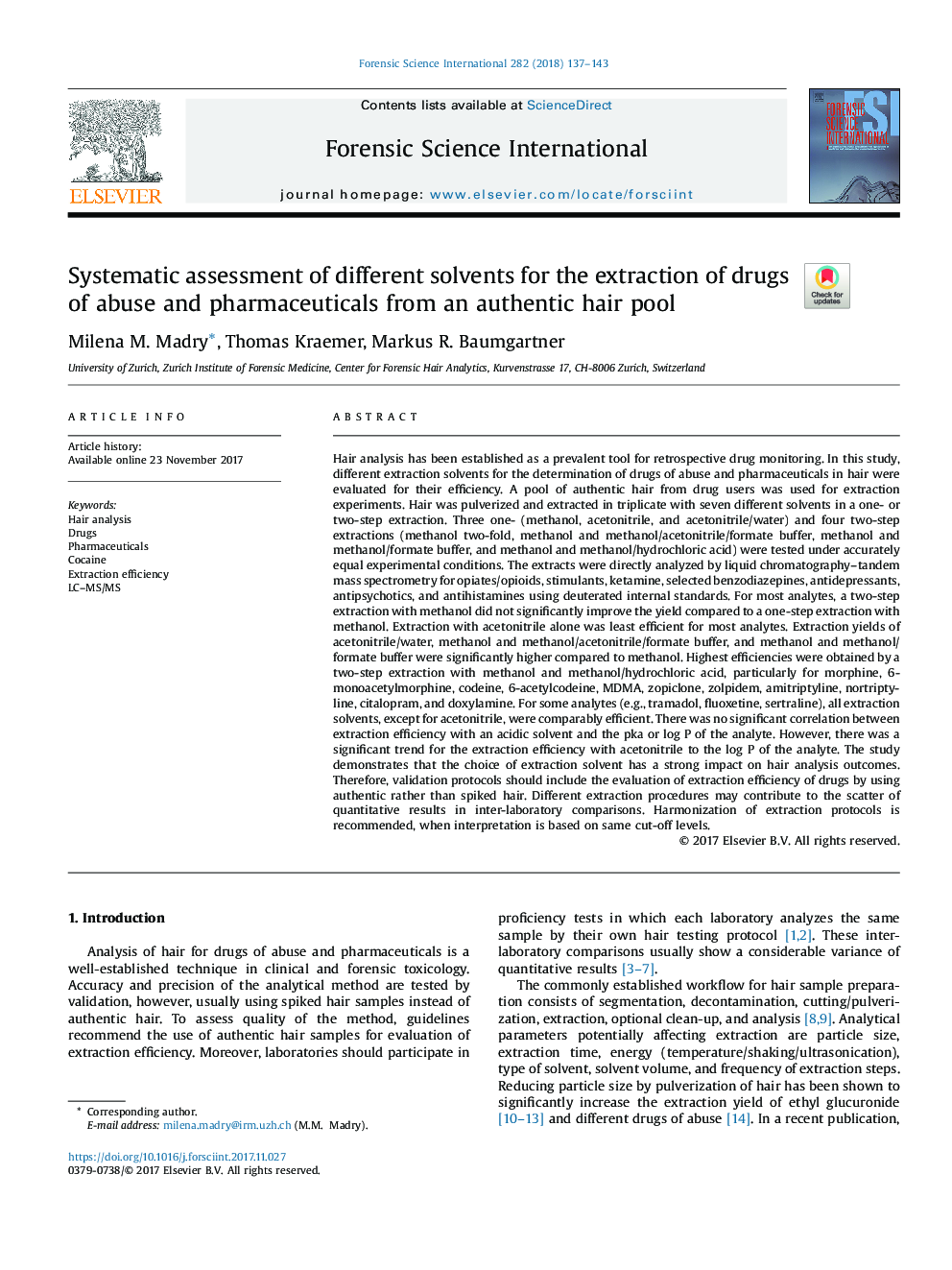| کد مقاله | کد نشریه | سال انتشار | مقاله انگلیسی | نسخه تمام متن |
|---|---|---|---|---|
| 6551395 | 1421968 | 2018 | 7 صفحه PDF | دانلود رایگان |
عنوان انگلیسی مقاله ISI
Systematic assessment of different solvents for the extraction of drugs of abuse and pharmaceuticals from an authentic hair pool
ترجمه فارسی عنوان
ارزیابی سیستماتیک از حلال های مختلف برای استخراج داروهای سوء استفاده و داروها از یک پایه موی مو
دانلود مقاله + سفارش ترجمه
دانلود مقاله ISI انگلیسی
رایگان برای ایرانیان
کلمات کلیدی
موضوعات مرتبط
مهندسی و علوم پایه
شیمی
شیمی آنالیزی یا شیمی تجزیه
چکیده انگلیسی
Hair analysis has been established as a prevalent tool for retrospective drug monitoring. In this study, different extraction solvents for the determination of drugs of abuse and pharmaceuticals in hair were evaluated for their efficiency. A pool of authentic hair from drug users was used for extraction experiments. Hair was pulverized and extracted in triplicate with seven different solvents in a one- or two-step extraction. Three one- (methanol, acetonitrile, and acetonitrile/water) and four two-step extractions (methanol two-fold, methanol and methanol/acetonitrile/formate buffer, methanol and methanol/formate buffer, and methanol and methanol/hydrochloric acid) were tested under accurately equal experimental conditions. The extracts were directly analyzed by liquid chromatography-tandem mass spectrometry for opiates/opioids, stimulants, ketamine, selected benzodiazepines, antidepressants, antipsychotics, and antihistamines using deuterated internal standards. For most analytes, a two-step extraction with methanol did not significantly improve the yield compared to a one-step extraction with methanol. Extraction with acetonitrile alone was least efficient for most analytes. Extraction yields of acetonitrile/water, methanol and methanol/acetonitrile/formate buffer, and methanol and methanol/formate buffer were significantly higher compared to methanol. Highest efficiencies were obtained by a two-step extraction with methanol and methanol/hydrochloric acid, particularly for morphine, 6-monoacetylmorphine, codeine, 6-acetylcodeine, MDMA, zopiclone, zolpidem, amitriptyline, nortriptyline, citalopram, and doxylamine. For some analytes (e.g., tramadol, fluoxetine, sertraline), all extraction solvents, except for acetonitrile, were comparably efficient. There was no significant correlation between extraction efficiency with an acidic solvent and the pka or log P of the analyte. However, there was a significant trend for the extraction efficiency with acetonitrile to the log P of the analyte. The study demonstrates that the choice of extraction solvent has a strong impact on hair analysis outcomes. Therefore, validation protocols should include the evaluation of extraction efficiency of drugs by using authentic rather than spiked hair. Different extraction procedures may contribute to the scatter of quantitative results in inter-laboratory comparisons. Harmonization of extraction protocols is recommended, when interpretation is based on same cut-off levels.
ناشر
Database: Elsevier - ScienceDirect (ساینس دایرکت)
Journal: Forensic Science International - Volume 282, January 2018, Pages 137-143
Journal: Forensic Science International - Volume 282, January 2018, Pages 137-143
نویسندگان
Milena M. Madry, Thomas Kraemer, Markus R. Baumgartner,
